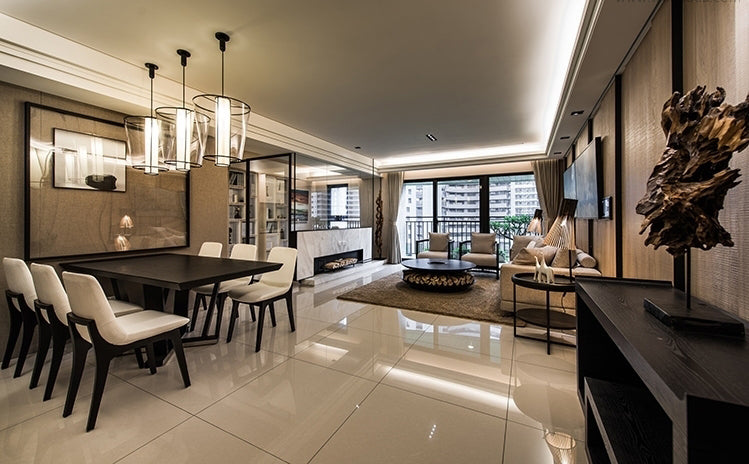Introduction
The practice of site selection was first recorded in the middle of the Shang Dynasty (1755-1046 BCE), when royal diviners queried Shang Di, the High God, on the efficacy of a particular time for establishing a city. These particular ancient textual passages were recorded on oracle bones; from this time, it is thought that this method of divination was also used to determine the efficacy of a particular place.
Whether you live in an urban environment or in a country location, there are elements to consider when selecting and assessing a site. If you're about to move, or are fortunate enough to have a site, choices you make have the capacity to affect your well-being and happiness. Investigating the immediate environment is a good start. Issues might include proximity to schools, parks, the town center or your workplace, plus proposed road and building developments or local architecture. Natural phenomena must also be taken into consideration. Rainfall, flood areas, wind direction, sun direction, soil type, height above sea level and geological faults are also relevant.
You need to remember that the modern world has problems which did not exist in the ancient world, and these must be taken into consideration when applying Feng Shui today. In the ancient world, auspicious site selection wasn't hampered by the negative aspects of factories, gas stations, electricity sub-stations, skyscrapers, 24-hour nightclubs, traffic or airports. Over a period of time, the by-products of modern living have the capacity to affect our general health, physiological well-being and ability to relax. This is particularly the case if these elements are in close proximity to, or have an affect on, the noise or pollution levels around your home. The art and science of Feng Shui can help us identify these influences and guide us with precautionary measures.
House design and balance
Good Feng shui is about creating and maintaining balance between the various elements of the environment. When designing or selecting your home, keep balance as a high priority. Keep an eye on the dimensions of the house relative to its surrounding environment. Look at the size and number of the doors, windows and rooms. Balance sun-filled and shaded areas within the home, greenery and bricked areas, colors, the elements of yin and yang and the five elements.
Interior balance is also reflected in the ratio of windows to doors and in the size and height of the rooms. Large, airy rooms are better than small rooms, but they should not be too large, too high or out of proportion with the home. The direction a building faces will affect its Qi- when a building doesn't receive any sun for light, warmth and color, the energy inside it can become stagnant and stale. A house flooded with sunshine, on the other hand, will have strong yang energy, and will need to be cooled with softer yin colors.
Balance creates harmony, which in turn creates good Qi in the home. If your home is so large that it dominates your site, ensure that you have compensating features designed into the house plan - outdoor lights can extend the yard, and dark color schemes can balance the yang force of such a house. Plots with generous amounts of land, on the other hand, are excellent, and conducive to the flow of Qi. Miserly and constrained dwellings stifle the flow of Qi.
A house in the center of the plot, with neither the front nor the back yard too spacious or too constrained, is best. Trees or plants are an excellent way to camouflage irregularities. If you are in doubt about which way to position your house, look for land which allows you to face south. Many Feng Shui masters in both the southern and northern hemispheres advocate this, based on the belief that the south is a source of wealth. Some Feng Shui practitioners maintain that where terrain has been scarred or cut, the exposed earth symbolizes the blood of an injured dragon. Others claim the worst direction for your home is facing northeast, as it represents the gateway of hell. Whatever the direction your home faces, it is important to ensure the front is not messy or overgrown, making it hard to access.
Good design and balance are not isolated to the structure and direction of your home, they also relate to your plot of land. It is considered vital for tapping auspicious 'earth luck' to maintain a balanced relationship
between the two.
House shapes
Square or rectangular shapes are much more conducive to Feng Shui than those which have protruding extensions, or which are L-shaped, U-shaped or wedge-shaped. Regularly shaped houses are considered balanced and complete, lending themselves to Feng Shui enhancement.
Houses with too many corners are to be avoided. The sharp angles are bad Feng Shui. The Chinese believe that L-shaped houses create imbalance, and so bring bad fortune they should be avoided at all costs.
The residents of a U - shaped house face equally bad fortune. The rules for house shapes also apply to apartment shapes. Square or rectangular layouts are preferable. As this is seldom possible, it is advisable to try to do something about correcting an irregular shape. Mirrors can be used to extend L- shaped apartments. A bank of lights can be placed along the wall of an elongated apartment to extend its shape.
Try to avoid large or many - angled roof lines, as these cause harm to neighboring properties. In symbolic terms, roof lines can be compared to hill shapes, and to their elemental associations. It is advisable to check the productive and destructive cycles of the elements. Roofs which have as hallow pitch resemble hills, which are linked to the Earth element, and are auspicious. Steeply pitched roofs represent the Fire element and are inauspicious. Apartment blocks with flat roofs suggest hills with flat plateaus-these are not very favorable. The ideal is to have a gentle, sloping roof line, which represents gentle, undulating mountain shapes.
Rooflines can be symbolically compared to hill shapes, and to their elemental associations. This gentle, shallow roof pitch is ideal, as it represents a gentle, undulating mountain.
Steeply pitched roofs represent the Fire element, and are considered to be inauspicious. If you are in the fortunate position of designing or selecting your home, make roof pitch and balance a high priority. Also, keep an eye on the dimensions of the house relative to its surrounding environment - because the trees surrounding this house are tall, the pitched roof isn't out of proportion. Applying good Feng Shui is about creating and maintaining balance between the various elements of your environment.
The illustrations below represent various inauspicious house shapes. Square or rectangular houses are much more conducive to good Feng Shui than those which have protruding extensions, or which are L-shaped, U-shaped or wedge-shaped. Avoid houses with too many corners or sharp angles.
An L-shaped house is considered inauspicious - the Chinese believe an L-shaped house resembles a knife or meat cleaver. This shape will bring bad fortune to its residents.
The residents of a U-shaped house face equally bad fortune. This configuration is thought to bring unhappiness.
This illustration shows a house with too many sharp angles and corners -these can create hard-hitting poison arrows.
A square house or apartment is considered very auspicious, bringing good luck to the residents.
A rectangular dwelling, as shown here, is preferable to an irregularly shaped one.
The same rules apply to apartment shapes as to house shapes. Regularly shaped dwellings, such as square or rectangular layouts, are considered balanced and complete, lending themselves to positive Feng Shui. Unfortunately, apartments with these shapes are rare; it is advisable to try to do something to correct irregularly shaped apartments. Mirrors can be used to extend L- shaped apartments. Or a bank of lights can be placed along the long wall of an elongated apartment to extend its shape.

